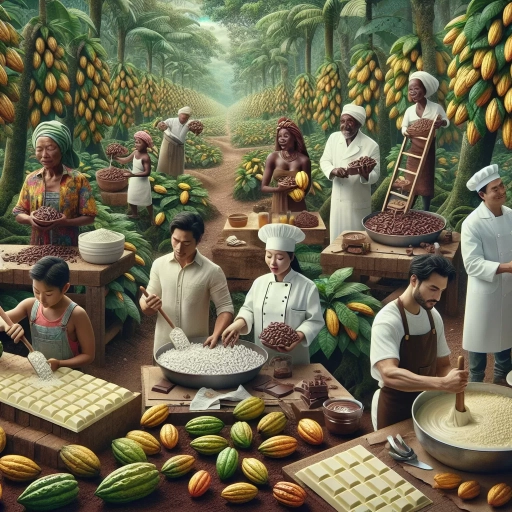How Is White Chocolate Made

Understanding White Chocolate
The Birth of White Chocolate
The category of chocolate that we refer to as 'white' is actually a direct byproduct of the process of making dark and milk chocolate. In the earlier part of the 20th century, European chocolatiers looking for ways to use excess cocoa butter, a byproduct of chocolate liquor production, created the first commercially available white chocolate. Nestle launched the Milkybar in Europe in 1936, making it the first white chocolate bar ever mass-produced.
What Exactly is White Chocolate?
To understand how white chocolate is made, we first need to acknowledge what it is and what it isn't. By definition, white chocolate is not technically chocolate because it does not contain any chocolate solids, or cocoa powder. The key ingredients in white chocolate are cocoa butter, sugar, and milk solids. Some interpretations may include vanilla and lecithin. According to definitions laid out by the Food and Drug Administration in the United States, anything labeled 'White Chocolate' must contain at least 20 percent cocoa butter, 14 percent total milk solids, and 3.5 percent milk fat, and no more than 55 percent sugar or other sweeteners.
Crucial Roles of Each Ingredient
It's the cocoa butter that gives white chocolate its creamy texture and allows it to melt in your mouth. Sugar provides the sweetness, while milk solids add a hint of dairy flavor. These ingredients are crucial not just for their flavors but their interplay. Cocoa butter, sugar, and milk solids each have different melting points, a disparity that is carefully managed during the chocolate-making process.
The Detailed Process of Making White Chocolate
Creation of Cocoa Butter
Creating cocoa butter is the first step in the process of making white chocolate. It involves separating the cocoa solids and cocoa fat from the cocoa bean. The beans, once harvested, are opened to reveal the cacao nibs. Nibs are then roasted, a step that develops the flavor, before being ground into a thick paste known as chocolate liquor. This liquor is then pressed to separate the cocoa solids from the cocoa butter.
Mixing Key Ingredients
Post creation of cocoa butter, the next step is to mix the key ingredients in the right proportions. This includes a mixture of milk solids, sugar, and your desired level of sweetness, before adding the cocoa butter. One key aspect here is the careful heating process that needs to be maintained while mixing these ingredients. A good chocolatier will ensure there are no sugar crystals remaining by heat-treating the mixture, a process known as conching, for up to 12 hours.
Tempering Stage
The final step in making white chocolate is the tempering stage. This is where the mixture is cooled and then slowly reheated to reach a temperature that allows it to set properly. This stage is vital for producing chocolate that has a glossy finish and a good 'snap' — two indicators of well-made chocolate. The tempered white chocolate is then poured into molds and allowed to set before it is finally ready to be enjoyed.
Exploring the Varieties of White Chocolate
Artisanal White Chocolate
While mass-produced white chocolate is made primarily from cocoa butter, sugar and milk solids, artisanal chocolate makers often choose to add additional ingredients to create unique flavor profiles. These may include things like sea salt, vanilla bean, matcha, or even fruits and nuts. Artisanal white chocolates tend to be lower in sugar and may use creamy whole milk or goat's milk to create a richer, creamier texture.
Vegan White Chocolate
For those who abide by a vegan lifestyle or allergy considerations, traditional white chocolate is off-limits due to its dairy content. However, vegan white chocolate substitutes the milk products with plant-based alternatives such as almond milk, coconut milk, or soy. The vegan variants still retain their essence of the luxurious creamy texture that is characteristic of white chocolate.
Gourmet White Chocolate
Gourmet white chocolate takes the sweetness of white chocolate and pairs it with unique flavors like lavender, rose, earl grey tea, or even whiskey. These chocolates are often handcrafted, and every bite provides a completely new experience, making it a perfect gift for a loved one, or a delightful indulgence for a special occasion.